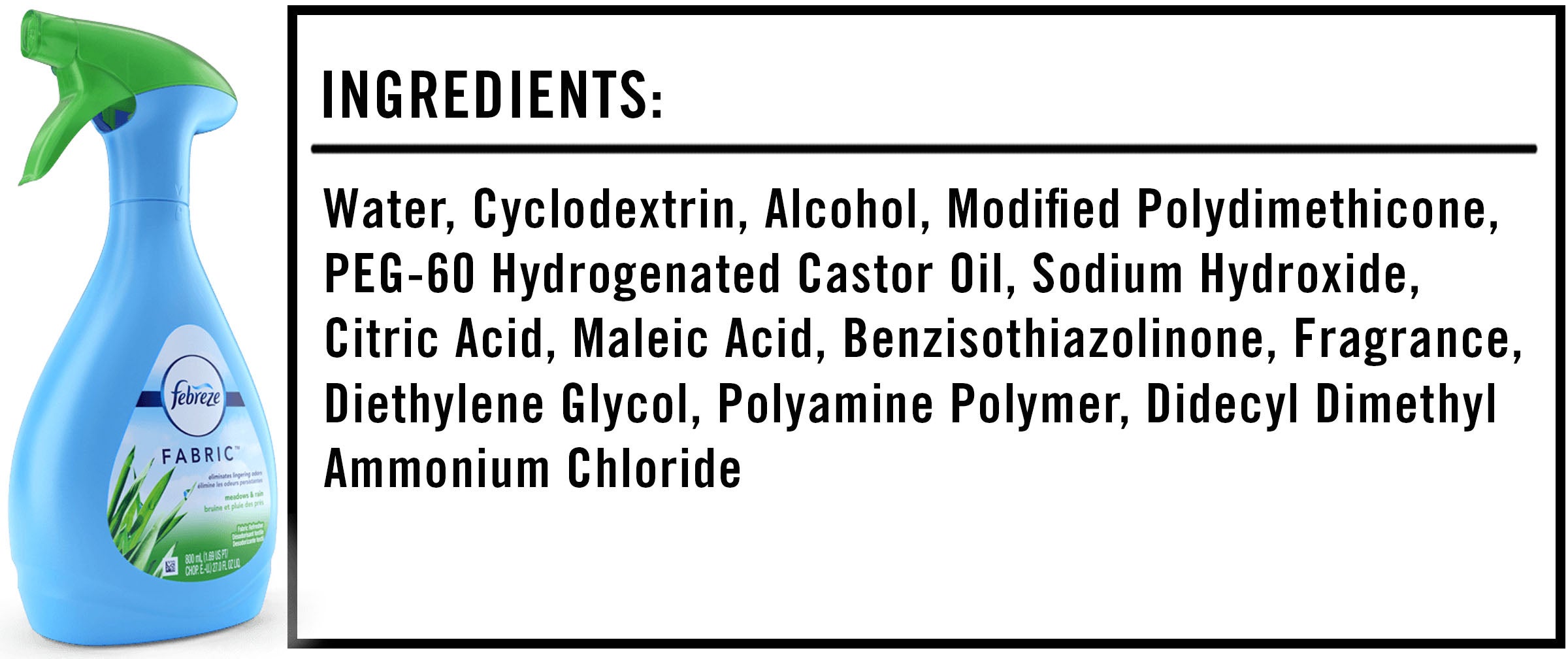We’re often told that you should never eat anything (or put anything on your body) if you don’t recognize everything on the ingredients list. But since most of us have no idea what xanthan gum or potassium benzoate are — or more importantly, what they’re doing to our bodies — we’re decoding the ingredients in the many things Americans put in (and on) themselves.
This edition: Febreze Fabric Refresher (Meadows & Rain), which is made from 13 separate ingredients that we’ve broken down in the exact order they appear online.

The Ingredients
1) Water: This helps to disperse the other ingredients.
2) Cyclodextrin: This is one of the main odor-busting ingredients in Febreze. Cyclodextrins are compounds made with cornstarch, and they essentially trap odor molecules. These compounds form a ring with a hydrophobic (or water-repellent) center. Meanwhile, many odor molecules are also hydrophobic, and since hydrophobic molecules tend to attract each other, the odor molecules are inevitably drawn to the center of the cyclodextrin ring, where they get stuck. Therefore, when you spray Febreze, these odor molecules are no longer floating around in the air — since they’re trapped in that cyclodextrin ring — which means your odor receptors can no longer sense them.
In other words, Febreze doesn’t really eliminate odors; it hides them.
3) Alcohol: Alcohol is a common cleaning agent. In the case of Febreze, it’s particularly useful, since it dries quickly and won’t soak too deep into whatever fabric you spray this stuff on.
4) Modified Polydimethicone: When modified, polydimethicone can act as a penetrant, which would help Febreze remove odors that are deeply embedded in, say, your stinky couch.
5) PEG-60 Hydrogenated Castor Oil: This is derived from (you guessed it) castor oil, and it has several uses in both cosmetics and cleaners. In the case of Febreze, though, it seems to act as a surfactant — that means it helps the ingredients blend together so every last spritz works as expected.
6) Sodium Hydroxide: This is another common — albeit, extremely potent — cleaning agent. It might also be added to control the pH value, which basically keeps the product stable for long periods of time. In higher concentrations, sodium hydroxide can aggravate the skin, but the amount in Febreze is probably nothing to worry about. Still, I wouldn’t recommend spraying yourself with Febreze. This isn’t deodorant, kids.
7) Citric Acid: Citric acid is found in many household cleaners, since it kills bacteria, mildew and mold. It might also serve as a preservative, keeping Febreze fresh while it sits under your kitchen sink.
8) Maleic Acid: Maleic acid works as a pH modifier, which can apparently help to neutralize the pH of certain bad smells, helping them smell more… well, neutral.
9) Benzisothiazolinone: Benzisothiazolinone is found in many cleaning products (laundry detergents, fabric softeners, stain removers) due to its antimicrobial and preservative properties. Like many other ingredients in Febreze, it can irritate the skin and eyes.
10) Fragrance: This is where the “Meadows & Rain” scent comes from. Because fragrance recipes are considered to be proprietary information, the FDA doesn’t require companies to list the ingredients that make up a fragrance, so we really have no idea who, what, where, when or why this particular fragrance has been deemed “Meadows & Rain.” In other words, this ingredient could very well have another ingredients list all of its own.
Now, none of this necessarily means you should be worried about this ingredient. In fact, fragrance ingredients are regulated by the Consumer Product Safety Commission, so theoretically, they should be at least generally safe. That said, fragrances tend to be the leading cause of cosmetic contact dermatitis (i.e., a skin rash caused by contact with a certain substance). There’s an easy fix for that, though: Either stop spraying Febreze on you skin, or try a different smelling one next time around.
11) Diethylene Glycol: Diethylene glycol can be used as a hygroscopic solvent, which means it absorbs moisture — and perhaps any odors associated with that moisture — from the air. In other words, it works similar to cyclodextrin.
Unfortunately, as one study points out, diethylene glycol is extremely toxic and has been “involved in a number of prominent mass poisonings spanning back to 1937.” The earliest and most famous example of these poisonings happened in the fall of 1937, when 71 adults and 34 children died after taking a drug called Elixir Sulfanilamide, which was meant to treat several ailments, ranging from sore throats to gonorrhea. At the time, nobody knew that the 72 percent diethylene glycol in the concoction would cause kidney failure, and eventually death — although, researchers quickly came to that conclusion once people started dying. Animal testing also wasn’t a thing back then (at least, it wasn’t required by law), so the manufacturers pretty much just released their drug and hoped for the best, which obviously didn’t end well.
While this event was obviously tragic, it did lead to the passage of the 1938 Food, Drug and Cosmetics Act, which gave the FDA the power to monitor the safety of new drugs. So yeah, lesson learned: Don’t let people release drugs to the public will-nilly, and don’t go drinking Febreze.
12) Polyamine Polymer: Again, similar to cyclodextrin, polyamine polymers essentially attract odor molecules.
13) Didecyl Dimethyl Ammonium Chloride: This is a common antiseptic (or disinfectant) often used in hospitals and hotels — anywhere that needs to be disinfected on a deep level.
The Takeaway
This truly is some scientific shit, but overall, Febreze should effectively cover lingering odors (although, again, it doesn’t completely eliminate the source of these odors — it just hides them). That said, studies frequently show that household cleaners can cause all sorts of bodily issues, from skin irritation to full-blown cancer, so maybe consider using it sparingly, and definitely don’t spray Febreze in your mouth.

